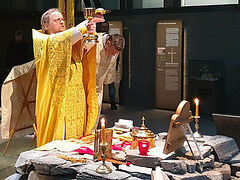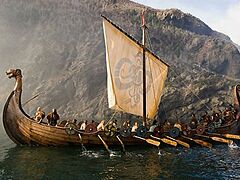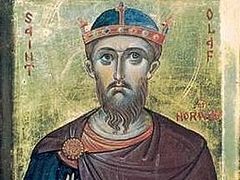 Priest Dimitry Ostanin with parishioners
Priest Dimitry Ostanin with parishioners
Fr. Dimitry Ostanin talks about how he and his found themselves in Bergen, Norway, the solicitude of Norwegian Catholic nuns, multi-lingual parish life, and the search for a tunnel.
—Fr. Dimitry, how did you end up in Norway?
—I first came here by chance. A spiritual daughter of my father-confessor told him that Oslo needed a temporary replacement for the choir director. I wrote to the rector of St. Olga’s parish in Oslo, Hieromonk (now Archimandrite) Clement (Huhtamäki) and said that I would like to come as a choir director and have some practice. Fr. Clement liked the idea, and I spent three months in Norway.
—When was that?
—In the spring of 2006.
—Was that your first trip abroad?
—Yes, it was.
—What are your feelings after thirteen years in Norway?
—The most important lesson from my life in Norway is that we must learn to be happy. This is not built into us, we have to cultivate it. When people far from their homeland come to church, with their pressing family and financial problems, not knowing the local language, the constant rain and lack of sun, I always tell them: Try and smile at the people who walk towards you. Try and marvel at how long it can rain. Try to find someone worse off than you and help them. You will be surprised how your inner world will change, and the world around you too. Because a person is more than his conditions, and is more important than them because God communicates with him, and through him with all created beings. You have to just overcome your self, open up to God and to people. Believe me, even though we see so much evil inside and outside ourselves, there is also good.
—Did you immediately end up in Bergen upon arriving in Norway?
—Not right away. It was a few years after I returned from Norway that was I invited to the Department for External Church Relations for an audience with Metropolitan Kirill, the current Patriarch of Moscow and All Russia. He suggested that I think about Norway. I had just gotten married and was waiting for the time when I could take my wife home to St. Petersburg. The decision was made immediately. I gave my consent. His Holiness blessed me to work at the DECR. While working there, he also ordained me first into the deaconate in Kaliningrad, and then to the priesthood in Smolensk. My wife Yulia was with me in Smolensk, and during a celebratory dinner for my ordination His Holiness asked Yulia if she had any objection to moving to Norway. She said firmly that she didn’t, and six months later we were already in Bergen.
—Orthodox Christianity is not a traditional religion for Norway. When did the first parishes appear here?
—As strange as it may sound, Orthodoxy is by no means a foreign historical form of Christianity for Norway. Christianity has long and deep roots here. More than 1000 years ago the Christian faith reached Norway with traders and travelers and soon bore fruit: the Orthodox saints Sunniva, Olaf and Hallvard.
Encounters with Christianity and subsequent conversions were embodied in the early Christian kings of Norway, such as Haakon the Good, Olaf Tryggvason, St. Olaf Haraldsson, Magnus the Good, and Harald Hardrada. They were Viking kings and had contacts with Christian countries, which eventually led to them adopting Christianity. They brought Eastern Christianity home, built churches dedicated to Eastern saints, and brought monks and priests from the Orthodox East. St. Olaf spent several years in Russia. His predecessor, Olaf Tryggvason, was raised in Ancient Rus’, was acquainted with the Equal-to-the-Apostles Prince Vladimir and grew up under his protection. Magnus the Good, St. Olaf’s son, grew up there too. Harald Hardrada, St. Olaf's half-brother, spent many years in the East—seven of them in Constantinople—where he became head of a Varangian Guard. He twice stayed in Kievan Rus where he married Elizabeth, the daughter of Prince Yaroslav the Wise and St. Anna of Novgorod. St. Anna herself (before Baptism—Ingegerd) was the eldest daughter of a Swedish king, Olaf Skötkonung.
Before the Reformation in Norway, Orthodox missionaries worked in Eastern Finnmark. St. Tryphon of Pechenga preached Christianity among the Skolts—an indigenous people of northern Norway. He built a small chapel dedicated to St. George in Neiden—a Sami village that today lies on the Norway-Finland border—where visiting priests still celebrate services. The few remaining Orthodox Sámi attend services. So Orthodoxy in Norway has a solid historical foundation.
As for the modern history of the Orthodox Church in Norway, it began with a small group of Russians who fled from the Bolshevik Revolution. They settled in Oslo and founded the first Orthodox parish in what is now Norway in 1931. The parish dedicated to St. Nicholas belonged to the Archdiocese of Russian Orthodox Churches in Western Europe under the Patriarchate of Constantinople (the Rue Daru) and for a time was the only Orthodox parish in Norway. Now there are communities of the Russian, Serbian, Romanian and Bulgarian Churches here. The oldest of our parishes is the parish dedicated to the Equal-to-the-Apostles Princess Olga. The community recently celebrated its twenty-fifth anniversary.
—Now we can talk about your arrival. I really admire what you’ve accomplished—you took out a loan to buy a church building from the Lutherans, organized an Orthodox parish there, and started a business to pay off the debt to the bank. Please tell us this amazing story!
—When my wife and I arrived in Bergen, a group of Orthodox Christians was already here, and a Russian Orthodox Church parish was officially registered. However, it didn’t have a resident priest because Fr. Mikhail Selyavkin was formally the rector of the parish of Great-Martyr Irene in Stavanger. Services weren’t celebrated regularly. The parish was registered in 2004. Initially, services were held in Mariakirken, the ancient and easily most beautiful church of Bergen. But it was an unsuitable place for such a small parish as ours was at that time to worship there. Soon it was closed for repairs and we moved to the small, cozy St. Sunniwa’s Catholic Church adjacent to the hospital, which was once served by a Catholic female monastic order. We used that church absolutely free of charge for four years. We once again resorted to the help of the sisters when the church was being renovated. Then we served immediately after the Catholic Mass in their church. While I was vesting myself for the Liturgy, the Catholic priest was unvesting himself after the Mass. The sisters came to our service almost every time, kissed the cross, received small pieces of prosphora and went to their cells. And the older sister stayed and served us coffee in the living room. The sisters were so kind to us and always brought sweets to our children. We had no iconostasis and served on an platform, so these were quite “missionary” liturgies. It was especially nice when we explained the main parts of the service while serving.
After a while the hospital was converted into a Catholic school, and its administration demanded payment for the church use. So we had to look for new premises. We continued to serve at St. Sunniwa’s Church while continuing our search. The main newspaper in Bergen, Bergens Tidende, published an article entitled, “Priest Looking for a Tunnel.” We had just returned from Jerusalem. I was so inspired by what I had seen in the Holy Land that I decided to look for a “cave” for our parish. I wrote letters to some organizations that owned underground “kingdoms,” but in vain. The journalists found out about it and this is how a newspaper article came about, with a photo of me catching my daughter against the backdrop of a closed tunnel! To find unused tunnels I had to get acquainted with the urban underground. The parishioners and I visited several tunnels, abandoned houses and basements. It was very interesting.
In 2016, while on vacation, I received a message that a traditional Norwegian prayer house was for sale. Earlier I had set up an automatic keyword search in case someone was selling something. Two years earlier, the parish council had decided to open a special account for donations for the purchase of a church and, thanks to savings and donations, we saved a decent amount by 2016. Though this wouldn’t have been enough to buy an apartment, let alone a church. But God helped us (laughs).
I contacted the parish council and suggested that we go and see. We had already attempted to make this building our home. About three years before I had made an attempt to find its owners, albeit unsuccessfully! It somehow belonged to two organizations simultaneously, one of which had not existed for some time. The difficulty was also in the fact that the owners were a specific organization. In the mid-eighteenth century, Norway was in union with Denmark and was ruled by King Christian IV. In 1741, he issued a decree forbidding unordained individuals to preach and lead worship services. The law was aimed against the pietistic movement in Denmark but also affected Norway. Those who opposed it formed a movement at the end of the same century, which became the basis for the bedehusbevegelse, literally, “the prayer house movement.” That law remained in effect until 1842. They are something like the Bespopovtsy (the “Priestless” denomination of Old Believers) in the Lutheran world. Although they baptize their children in Lutheranism, they remain very isolated. The women's movement originated in the depths of the bedehusbevegelse. They were responsible for youth sport organizations too. They have become centers of democracy, as it were, and not only in the Church. Our church was built in 1938.
Today the bedehusbevegelse are on the sidelines. They are very conservative when it comes to morality. Their numbers keep declining, the remaining active members are elderly and these houses of worship are often put up for sale. So we bought one of them. We won the auction and signed a contract to buy it.
—Let’s talk about your parish, parishioners and their activities.
—When I was studying in theological schools, I couldn’t have imagined that I would serve in such a diverse community. When I arrived in Bergen, I was the only permanent Orthodox priest. We had a lot of Serbs, Romanians, and Bulgarians in the church. There were also Greeks, Orthodox Christians from India, Japan, the USA, and converts from the Oriental Orthodox Churches. We had two professors—a married couple from the USA—whom I received into Orthodoxy from Anglicanism.
As national Orthodox groups grew, their Churches sent their priests. Today in our city there is a community of Romanians headed by my good friend, Father Andrei, and a group of Serbs which is regularly visited by a Serbian priest from Oslo. The Greek Archimandrite Alexander pastors a small community of Greeks and enjoys our hospitality about two or three times every three months, serving the liturgy in Greek in our church. One of our former parishioners became a priest of the Exarchate of Western Europe and is now under the jurisdiction of the Russian Orthodox Church. He is a Norwegian convert and now heads a parish of Orthodox Norwegians. We also have a group of Orthodox Russians and Norwegians served by Archimandrite Johannes from Oslo under the jurisdiction of the Serbian Patriarchate. Not long ago, they bought their own small church apartment. Most of the funds were donated by the retired priest himself and Hierodeacon Seraphim who serves with him.
This diversity gives an incentive: I have learned Serbian from my parishioners, I understand spoken Bulgarian, and speak and write in Norwegian. Sometimes in the refectory we have a “linguistic community,” discussing our Slavonic languages. Russians, Ukrainians, Serbs, Bulgarians, Moravians, Rusyns (from Poland, Romania, Slovakia) sit around the same table. Although the bulk of parishioners are Russian-speaking, the countries they came from make up half of the globe: Ukraine, Russia, Belarus, the Baltic States, Portugal, Spain and many other countries. And then people leave and go to all directions from Australia to South America, but we keep in touch with our parishioners.
—In what language do you celebrate services?
—Since there is always someone from Serbia or Bulgaria at services, these two languages, along with Church Slavonic and Ukrainian, are in permanent use. Norwegian is also always used, even when our Norwegians are absent from services.
—Do these Norwegians have the opportunity to attend the Norwegian-speaking Orthodox parishes of Bergen?
—Language means a lot, but not everything. Most of us came to Norway from countries where religion, in particular Orthodoxy, plays an important role in life and culture. It is this experience of life in Orthodoxy that attracts Norwegians to our parish. Some of them learn Russian! There is a spiritual tradition here. It is very important that this tradition isn’t confused with a tradition based exclusively on culture and language. Otherwise, an Orthodox parish runs the risk of becoming a cultural and ethnic club. To love Christ in the Orthodox tradition is one thing, and onion domes and traditional pastry birds for the feast of the Forty Martyrs of Sebaste are something else. We are united by Christ in His Church, not by our origin, culture or language. And you should guide a person to Him rather than ensure that he becomes “Russian” or something else. The Russian Orthodox Church is the Mother for all its children, no matter what language they speak or where they are from.
—Do Norwegian converts have problems in their families? Are they accused of “betraying the faith of their ancestors?”
—(Laughs) Norwegians today are not very religious. Conversion to Orthodoxy for them is an intellectual choice in many ways. They are more likely to convert to Catholicism. But it affects things related to tradition. It is important for Norwegians to participate in the Baptism of their children, even if it takes place in Orthodoxy. They want the godfather or godmother to be from their circle, but there’s a problem: they cannot be godparents since they aren’t Orthodox.
—Is there a way out of this problem?
—We make use of their casual attitude towards everything. When I suggest that they become nominal godparents, i.e. in a non-religious sense, they happily agree.
To be continued.




